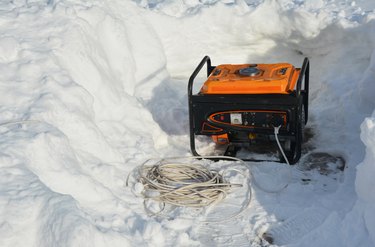
There are several reasons you might need to increase voltage output of a 120V generator to give you 240 volts. Generally speaking, the chief reason is to power a larger appliance that requires a 240-volt output. Converting a 120V generator to 240V is possible, and it is safe as long as you do it correctly. Improper conversion can cause accidents or injuries.
Set Up Your Electrical Transformer Generator
Video of the Day
Whenever you're working with any electrical appliance, you must take proper safety precautions. Wear protective gloves to prevent electrical shock and make sure the area around your work surface is dry. If your generator has a fuel tank, you can leave the fuel in it but be very cautious not to spill it.
Video of the Day
Ohm's Law explains why increasing the voltage on a generator is safe. According to this scientific principle, which George Ohm discovered in the early 19th century, the electric current times the voltage equals the wattage. Your generator will still be within its safe wattage when you increase the voltage because you will decrease the current simultaneously. Most 120V generators put out 15 amps, which resistance reduces to 7.5.
To increase voltage output and decrease the current on your electrical transformer generator, you need to use a step-up transformer with a 1:2 turn ratio. First, power off and disconnect anything currently connected to the generator. Then, attach the output power terminal from the generator to the step-up transformer. If it has one, connect it to the transformer on the primary coil side using the cable from the transformer's primary side. If it doesn't have one, use an extension cord.
Convert 120V to 240V
Now that you have connected the step-up transformer to the 120V generator, you can change the current voltage. Locate the labeled secondary side of the transformer. If you can't find it, you should refer to the user manual. Connect the load to it that requires 240V. Ensure that it does not require more than 7.5 amps or 1,800 watts, which is the maximum output of your generator.
Turn on the generator. While the generator itself will still only output 120V, the transformer takes those volts and amps and converts them to power a 240V appliance. You will need to leave the transformer attached for the entire time you plan to use 240 volts.
To convert the generator back to 120 volts, power off the appliance and unplug everything. After you've finished those steps, you are safe to disconnect the transformer, and you can use your 120V generator as usual.
Protect Your Generator and Prevent Accidents
Whenever you use a generator regardless of whether you're running it through a transformer or not, you must take a handful of precautions to protect the generator and ensure your safety. First and foremost, only use generators outdoors and keep them at least 15 feet away from your home and other structures. Keep it on a dry, steady surface underneath some kind of canopy or protection from the elements. Let it cool completely before refueling and avoid running out of fuel.
Before using a generator to run something, you should disconnect its regular power source, even if the power to your home is off due to an outage. Never plug your generator into a wall outlet or your electrical panel. Routinely check your generator for any signs of damage or wear and make repairs before attempting to use it again.